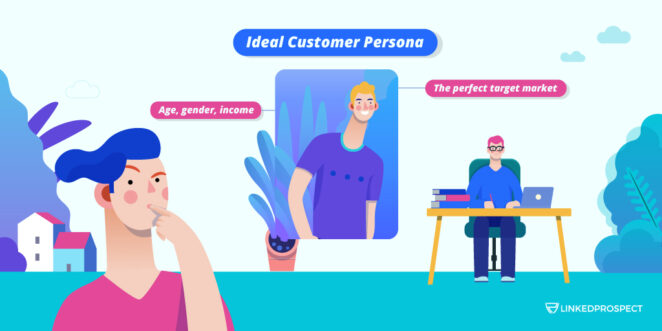

If you’re looking for a way to attract new customers and grow your business, you’ll want to read this article. You might also be wondering if LinkedIn ads are right for your business or where to even begin when building an ideal customer profile. In this article, we talk about the ideal customer profile, what it’s for, and how you can use it for your marketing campaigns.
Contents
What is an ideal customer profile?
An ideal customer profile is a description of your perfect target market. It’s usually created by combining several types of data, like demographic information (age, gender, income) and psychographic information (personality traits).
Ideal customer profiles are used to create marketing campaigns that speak directly to the target demographic. They help you put together better ads and social media posts, because they help you understand who your audience is and what they want.
If you don’t know who your customers are or what they want, how can you sell them something? You need to know who they are so you can connect with them on a personal level—and that’s what an ideal customer profile does: helps you connect with people on a personal level.
Ideal Customer Profile vs. A Buyer Persona
A buyer persona is a fictional representation of your ideal customer. It’s a way to help you understand your audience and their needs, wants, and desires better.
An ideal customer persona is similar, but it focuses on one specific person—your top buyer—instead of the entire group.

The main difference between the two is that a buyer persona is more detailed than an ideal customer persona. The buyer persona should include information about their personality traits and values, their purchase history, and other data that will help you create products or services that meet their needs.
Here are a few key differences:
A buyer persona is used by marketing teams to create marketing strategies for specific groups of customers, whereas an ideal customer profile (ICP) is created by sales teams to use as a guide for creating new products and services.
The difference in how they are created: Buyer personas focus on understanding external factors that impact buyers’ purchase decisions, whereas ICPs focus on understanding internal factors that impact the behavior of potential customers.
The difference in how they are targeted: Personas target individual people based on demographic characteristics, while ICPs target an entire market segment or industry segment.
The difference in how they are evaluated: Buyer personas address whether or not someone fits into your ideal customer profile based on their behavior, demographics and perceptions; however, ICPs address whether or not someone fits into your ideal customer profile based on behaviors toward the company itself rather than behaviors toward competitors’ products or services.
Step-by-step guide in creating an ideal customer persona
There are a few steps you can take to create your ideal customer persona.
- Define the problem you’re trying to solve: The first step is to define the problem that you’re trying to solve. What are your customers’ biggest challenges? What are their pain points? How can you help them?
- Create personas based on your customer information: Once you’ve figured out what your customers need, it’s time to create personas for them using data from surveys and focus groups. A persona is basically a hypothetical customer who represents a group of real customers with similar characteristics and needs. You’ll use these personas to guide your marketing efforts and target more directly in the future.
- Map out their journey through your product or service: Now that you know who your customers are, it’s time to map out how they interact with your product or service from beginning to end. This will help you understand how they feel about your company and where there might be room for improvement in their experience with you.
4. Prioritize their needs and frustrations based on user research results: If a lot of people said that they wanted something, but only a few people said they were frustrated by not having it, then it’s probably not worth prioritizing that need. And if only a couple people mentioned a problem that they had with a product or service, but nobody else brought it up, then it might be worth putting some more thought into what that frustration means.
How to use your ideal customer persona for marketing and lead generation
It’s time to put your persona to work! Here’s how to use it for your marketing and lead generation efforts.
Find the common threads among your customers. If you’ve been doing market research to determine your ideal customer persona, you should have some idea of the common threads among all of your customers. If not, now is the time to do more research so that you can create a list of attributes that most of your current customers share. This will help you when it comes time to market your product or service and attract new ones as well.
Use this information to write compelling copy that appeals to these shared characteristics and interests as well as personalize it for each individual customer segment (where applicable). For example, if one group of customers is interested in yoga while another group prefers hiking, include both activities in the copy but make sure it’s relevant for each group!
Make sure that everything on your website speaks directly to these shared characteristics and interests as well—from blog posts about topics related to one’s chosen passion to efficient landing page copies that attract buyers!
Conclusion
Creating ideal customer personas is a great way to make sure you’re talking to the right people.

If you’re not sure how to create your ideal customer personas, there are lots of ways that you can get started. It’s all about figuring out what makes your brand unique, what makes it stand out from the crowd and why people should buy from you instead of someone else. From there, you can begin to build out your ideal customer persona based on their needs and interests, the demographics they fall into and what kind of language they speak when they talk about their experiences with your product.
It’s important to remember that creating personas is a process and not an end result. You can use this information to further develop your product, service, or brand—and continue to improve upon it over time!
